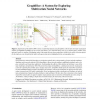710 search results - page 64 / 142 » An Architecture for Exploring Large Design Spaces |
CN
2007
13 years 7 months ago
2007
Worms are self-replicating malicious programs that represent a major security threat for the Internet, as they can infect and damage a large number of vulnerable hosts at timescal...
CE
2004
13 years 7 months ago
2004
Much computer-based learning is largely passive, based primarily on task-based, exercise-driven interactions. We argue that computers have greater potential for promoting more act...
CGF
2010
13 years 8 months ago
2010
Social networks collected by historians or sociologists typically have a large number of actors and edge attributes. Applying social network analysis (SNA) algorithms to these net...
IPPS
2006
IEEE
14 years 1 months ago
2006
IEEE
Performance and workload modeling has numerous uses at every stage of the high-end computing lifecycle: design, integration, procurement, installation and tuning. Despite the trem...
SIGOPSE
2004
ACM
14 years 1 months ago
2004
ACM
Web application workloads are often characterized by a large number of unique read requests and a significant fraction of write requests. Hosting these applications drives the ne...

